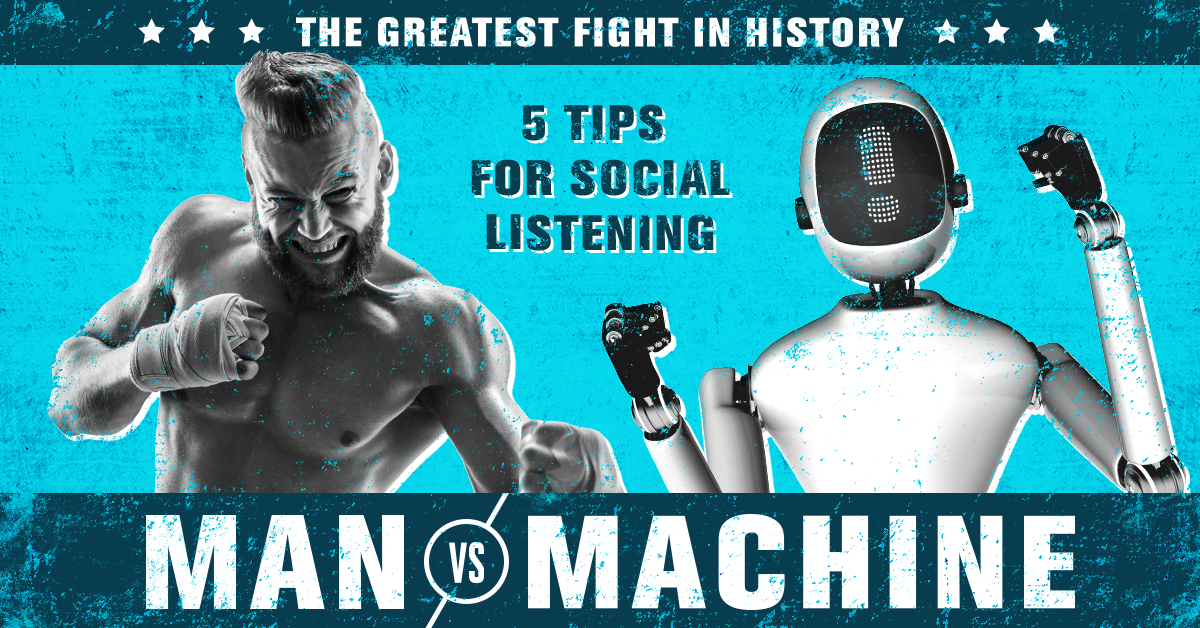Man vs. Machine: Who Will Win the Battle for Social Sentiment?

What came first: the chicken or the egg? Who reigns supreme: man or the machine man built?
The human programming of machine learning has given machines the upper hand in enabling them to think quick, think ahead and adapt to meet human standards of right or wrong. Need proof? Take a look at IBM’s Watson vs. the ultimate human champions of Jeopardy. Or read about AlphaZero’s matchup against human Grandmasters of chess. Each of these stories paints a not-so-pretty picture. Humans are doomed.
But is this always the case?
Recently one of our B2B tech clients hosted a large industry trade show. It was glorious and exciting and their social media plan was executed flawlessly. We pulled together a report of social conversation over the week-long conference, and an unusually large percentage of the sentiment was negative. How could this be?
I dug into the data and identified that one of the conference speakers discussed cleaning up waste from the ocean. This speech was social media gold. People were signing petitions, pledging to eliminate single-use plastics from their lives. They quoted, shared and celebrated the movement all over social media. And that’s where the ugly flaw of machine made itself known. Every post pledging to clean up “waste” was stamped by our rather expensive social listening tool as “negative sentiment.”
This got me thinking. Sometimes machine is better than man. And sometimes man is better than machine. But ultimately, the pairing of man with machine is how the future will roll forward.
So the next time you’re using or considering tools to report on social sentiment, keep these tips in mind — because machine is not always right.
Social Sentiment Analysis Best Practices
1. Never report on social sentiment results without analyzing samplings of the negative sentiment social posts themselves.
Your client hired you — a person — not a machine. If you drop those sentiment percentages blindly into your report, you’re not doing your job as an analyst. Read the posts deemed negative. Closely. Analyze them and let your client know what you found.
2. Sarcasm can be sneaky.
Take a peek at the positive posts as well. Sarcasm is a tricky thing for AI to navigate. “I had the best time assembling all 8,000 pieces of my new dresser” may sound like a great day to AI, but oozes sarcasm to the trained human ear.
3. Sometimes negative sentiment is a natural part of conversations.
Not every negative conversation is bad. Oftentimes people turn to social media to discuss difficult subjects, subjects that your social community or you — the brand — can support. Like caring for a loved one or struggles with a health issue. Take this into consideration when setting goals for your brand’s social sentiment.
4. Use social sentiment for adapting your approach to your content mix.
Challenge yourself to do more with the results of social sentiment analysis. You may be surprised to learn what items resonate best with your social community. When conversations and sentiments spike, discuss with your team ways those topics could become a larger focus for your brand’s presence on social.
5. While AI may not be perfect, it does help speed up the process of analysis.
By classifying large amounts of content into smaller buckets, machine learning can save you hours of time you would have spent combing through posts manually to classify sentiment yourself. Embrace that AI will likely never be spot-on. Use it as a tool to support you, the human, in your analysis.
At the end of the day, AI and machine learning can help guide data analysis. But ultimately, computers aren’t able to read and comprehend the intricacies of human emotion, sentiment and feeling. That’s where you come in.

Comments
Add A CommentThis is what every social media user should read about using social media daily. Thank you Amanda for such great information. And if you ask me, then I think here we humans can beat robots. It is my personal opinion it can be wrong.